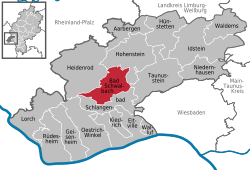Bad Schwalbach
| Bad Schwalbach | ||
|---|---|---|

A residential area in Bad Schwalbach
|
||
|
||
| Coordinates: 50°08′0″N 08°04′0″E / 50.13333°N 8.06667°ECoordinates: 50°08′0″N 08°04′0″E / 50.13333°N 8.06667°E | ||
| Country | Germany | |
| State | Hesse | |
| Admin. region | Darmstadt | |
| District | Rheingau-Taunus-Kreis | |
| Government | ||
| • Mayor | Martin Hußmann (Ind.) | |
| Area | ||
| • Total | 40.27 km2 (15.55 sq mi) | |
| Population (2015-12-31) | ||
| • Total | 10,697 | |
| • Density | 270/km2 (690/sq mi) | |
| Time zone | CET/CEST (UTC+1/+2) | |
| Postal codes | 65307 | |
| Dialling codes | 06124 | |
| Vehicle registration | RÜD, SWA | |
| Website | www.bad-schwalbach.de | |
Bad Schwalbach (called Langenschwalbach until 1927) is the district seat of Rheingau-Taunus-Kreis, in Hesse, Germany.
Bad Schwalbach is a spa town some 20 km northwest of Wiesbaden. It lies at 289 to 465 m above sea level in the Taunus, along the small river Aar (Lahn) (a tributary of the Lahn). Over 56 percent of the municipal area is forest.
Bad Schwalbach borders in the north on the community of Hohenstein, in the east on the town of Taunusstein, in the south on the community of Schlangenbad, and in the west on the community of Heidenrod.
Bad Schwalbach’s Stadtteile are Adolfseck, Bad Schwalbach, Fischbach, Heimbach, Hettenhain, Langenseifen, Lindschied and Ramschied.
Bad Schwalbach was first mentioned in a document in 1352 as Langinswalbach. The first reliable report of the mineral springs came in 1568 from the Worms doctor Tabernaemontanus, who also made the place known in his 1581 work Neuw Wasserschatz (New Water Resources). Although Langenschwalbach was utterly destroyed in the Thirty Years' War, it was quickly rebuilt, and the healing water trade began to blossom. At first, the water would be sold by the jug or barrel throughout Europe by mail order. Only a few seekers of healing undertook the arduous journey to the Taunus.
The health resort started at the beginning of the 19th century only after the improvement of road conditions through construction. The Aartalbahn (railway) from Wiesbaden to Langenschwalbach, finished in 1889, also contributed substantially to its founding. Many crowned heads, princes and counts then came to take the waters and visit the gaming parlours where few strict rules applied. After the end of the First World War, the nobility quickly lost importance and thus began the long, drawn-out and somewhat painful transition from a luxury spa to a public one, which only ended after the Second World War.
...
Wikipedia


